Subtribe Flueggeinae Higher classification Leafflower | Tribe Phyllantheae Genus Phyllanthus Rank Species | |
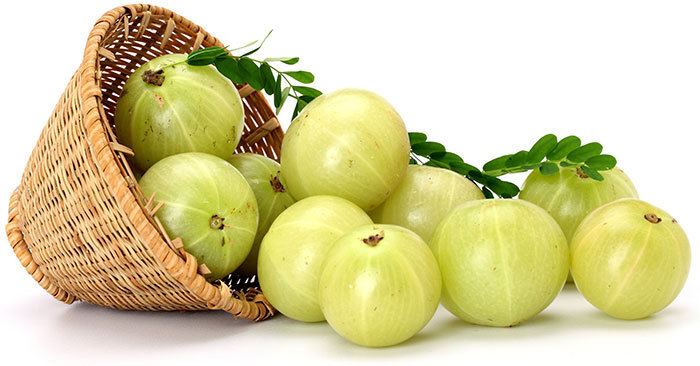 | ||
Similar Myrobalan, Gooseberry, Rennet, Acacia concinna, Holy Basil | ||
Amla trees in gurgaon orchard phyllanthus emblica
Phyllanthus emblica, also known as emblic, emblic myrobalan, myrobalan, Indian gooseberry, Malacca tree, or amla from Sanskrit amalika is a deciduous tree of the family Phyllanthaceae. It is known for its edible fruit of the same name.
Contents
- Amla trees in gurgaon orchard phyllanthus emblica
- Indian gooseberry phyllanthus emblica
- Plant morphology and harvesting
- Cultural and religious significance
- Traditional medicine
- Culinary use
- Other uses
- Research
- Chemical constituents
- Vernacular names
- References
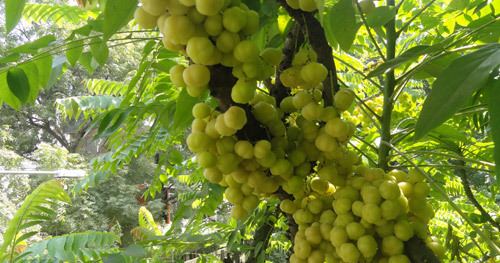
Indian gooseberry phyllanthus emblica
Plant morphology and harvesting
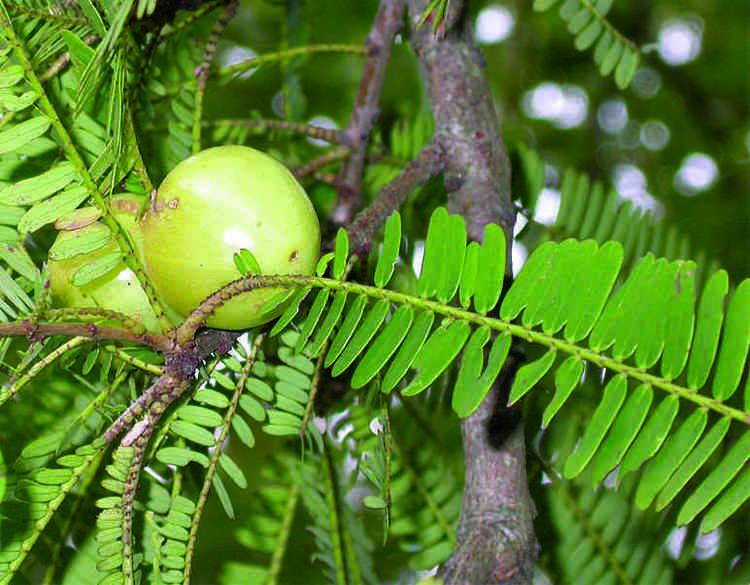
The tree is small to medium in size, reaching 1–8 m (3 ft 3 in–26 ft 3 in) in height. The branchlets are not glabrous or finely pubescent, 10–20 cm (3.9–7.9 in) long, usually deciduous; the leaves are simple, subsessile and closely set along branchlets, light green, resembling pinnate leaves. The flowers are greenish-yellow. The fruit is nearly spherical, light greenish yellow, quite smooth and hard on appearance, with six vertical stripes or furrows.

Ripening in autumn, the berries are harvested by hand after climbing to upper branches bearing the fruits. The taste of Indian emblic is sour, bitter and astringent, and it is quite fibrous. In India, it is common to eat emblic steeped in salt water and red chilli powder to make the sour fruits palatable.
Cultural and religious significance
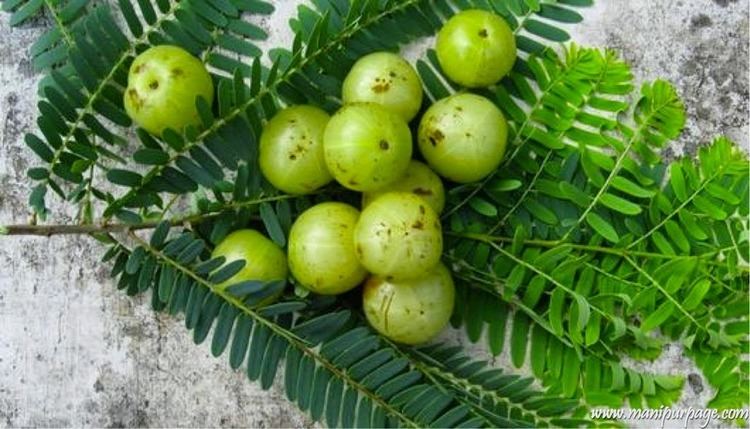
The tree is considered sacred by Hindus as God Vishnu is believed to dwell in it. The tree is worshiped on Amalaka Ekadashi.
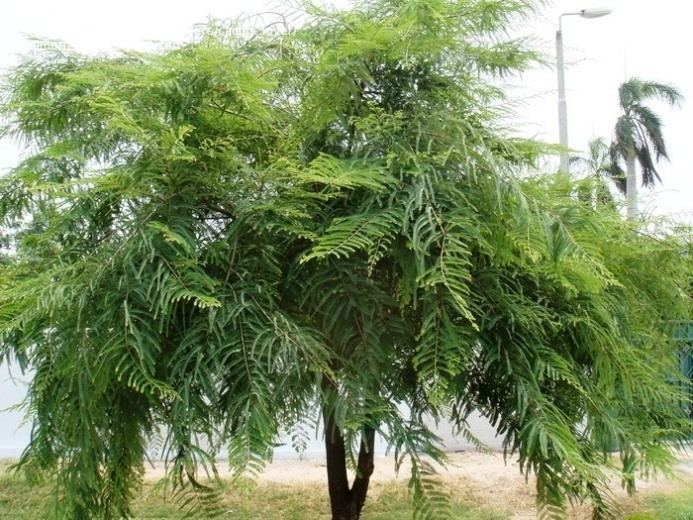
In other Hindu beliefs, Amla is said to have originated from the drops of Amrit which spilled on earth accidentally, because of the fight of Gods and Demons after ksheera sagar manthan. And hence also this religious belief makes claims that it almost cures every disease and is also good in extending the longevity of life.

In the Sanskrit Buddhist tradition half an amalaka fruit was the final gift to the Buddhist sangha by the great Indian emperor Ashoka. This is illustrated in the Ashokavadana in the following verses:

"A great donor, the lord of men, the eminent Maurya Ashoka, has gone from being lord of Jambudvipa [the continent] to being lord of half a myrobalan." (Strong, 1983, p. 99) This deed became so famous that a stupa was created to mark the place of the event in modern-day Patna and was known as the Amalaka stupa.
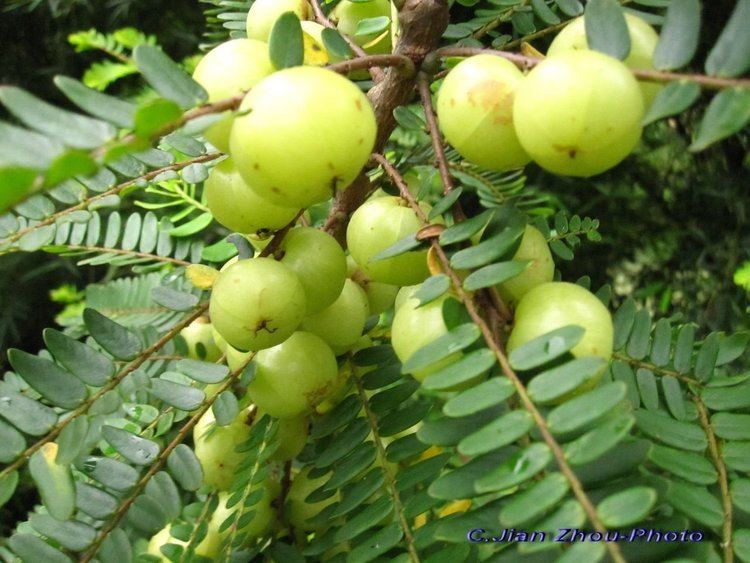
According to Hindu tradition, Adi Shankara of Kerala composed and recited the Kanakadhara stotram in praise of Mahalakshmi to make a poor Brahmin lady get wealth, in return for a single amla presented to him as bhiksha on an auspicious dwadashi day. Contemporary poet/philosopher Ravi Teja Yelamanchili wrote a book titled Amalaki. The book is based on Advaita Vedanta of Sri Adi Shankaracharya.
According to a Tamil legend, Avvaiyar (Tamil: ஔவையார்), a female poet, ethicist and political activist of the Sangam period was gifted with one amla by King Athiyaman to give her long life.
In Theravada Buddhism, this plant is said to have been used as the tree for achieving enlightenment, or Bodhi by twenty first Lord Buddha called "Pussa - ඵුස්ස".
Traditional medicine
In traditional Indian medicine, dried and fresh fruits of the plant are used. All parts of the plant are used in various Ayurvedic/Unani medicine (Jawarish amla) herbal preparations, including the fruit, seed, leaves, root, bark and flowers. According to Ayurveda, amla fruit is sour (amla) and astringent (kashaya) in taste (rasa), with sweet (madhura), bitter (tikta) and pungent (katu) secondary tastes (anurasas). Its qualities (gunas) are light (laghu) and dry (ruksha), the postdigestive effect (vipaka) is sweet (madhura) and its energy (virya) is cooling (shita).
According to Ayurveda, amla balances all three doshas. While amla is unusual in that it contains five out of the six tastes recognized by Ayurveda, it is most important to recognize the effects of the "virya", or potency, and "vipaka", or post-digestive effect. Considered in this light, amla is particularly helpful in reducing pitta because of its cooling energy. It also balances both Pitta and vata by virtue of its sweet taste. The kapha is balanced primarily due to its drying action. It may be used as a rasayana (rejuvenative) to promote longevity, and traditionally to enhance digestion (dipanapachana), treat constipation (anuloma), reduce fever (jvaraghna), purify the blood (raktaprasadana), reduce cough (kasahara), alleviate asthma (svasahara), strengthen the heart (hrdaya), benefit the eyes (chakshushya), stimulate hair growth (romasanjana), enliven the body (jivaniya), and enhance intellect (medhya).
In Ayurvedic polyherbal formulations, Indian gooseberry is a common constituent, and most notably is the primary ingredient in an ancient herbal rasayana called Chyawanprash. This formula, which contains 43 herbal ingredients as well as clarified butter, sesame oil, sugar cane juice, and honey, was first mentioned in the Charaka Samhita as a premier rejuvenative compound.
In Chinese traditional therapy, though this fruit is mentioned as yuganzi (余甘子), or you gan zi (油甘子), it is not commonly found in China.
Culinary use
Maharashtra is one of the largest producers and suppliers of Indian gooseberries. In this region the fruit is commonly pickled with salt, oil, and spices. The amla fruit is eaten raw or cooked into various dishes. In Andhra Pradesh, tender varieties are used to prepare dal (a lentil preparation), and amle ka murabbah, a sweet dish made by soaking the berries in sugar syrup until they are candied. It is traditionally consumed after meals.
In the Batak area of Sumatra, Indonesia, the inner bark is used to impart an astringent, bitter taste to the broth of a traditional fish soup known as holat.
Other uses
Popularly used in inks, shampoos and hair oils, the high tannin content of Indian gooseberry fruit serves as a mordant for fixing dyes in fabrics. Amla shampoos and hair oil are traditionally believed to nourish the hair and scalp and prevent premature grey hair.
In Kerala, well beds are lined with Emblica timber (നെല്ലിപ്പലക) to get clean and sweet water for drinking and cooking.
Research
There is preliminary evidence in vitro that extracts of P. emblica induce apoptosis and modify gene expression in osteoclasts. Experimental preparations of leaves, bark or fruit are under research on mechanisms of inflammation and alanine transaminase activity.
Chemical constituents
Although these fruits are reputed to contain high amounts of ascorbic acid (vitamin C), up to 445 mg per 100 g, the specific contents are disputed, and the overall antioxidant strength of amla may derive instead from its high density of ellagitannins such as emblicanin A (37%), emblicanin B (33%), punigluconin (12%) and pedunculagin (14%). It also contains punicafolin and phyllanemblinin A, phyllanemblin other polyphenols: flavonoids, kaempferol, ellagic acid and gallic acid.
Vernacular names
Names for this plant in various languages include:
lozü in Ao languages
halïlaj or ihlïlaj (اهليلج هليلج) in Arabic
amlakhi in Assamese
balakka in Batak language, an Indonesian language
amloki (আমলকী) in Bengali
amlai (आमलाइ) in Bodo language
anmole (庵摩勒) in Chinese
ambare (अमबरे) in Garo language
āmla (આમળાં) in Gujarati
ānvalā (आँवला) in Hindi
kantout Prei (កន្ទួតព្រៃ) in Khmer
bettada nellikaayi ಬೆಟ್ಟದ ನೆಲ್ಲಿಕಾಯಿ (ನೆಲ್ಲಿ / ನೆಲ್ಲಿಕಾಯಿ) in Kannada
sohmylleng in Khasi
āvāḷo (आवाळो) in Konkani
mak kham bom in Lao
melaka (ملاك) in Malay, A state in Malaysia, Malacca was named after this tree.
nelli (നെല്ലി) in Malayalam
heikru in Meitei
āvaḷā (आवळा) (or awla) in Marathi
sunhlu in Mizo
zee phyu thee (ဆီးၿဖဴသီး) in Myanmar
amalā (अमला) in Nepali
anlaa (ଅଁଳା) in Oriya
suaklu in Paite
aula (ਔਲਾ) in Punjabi
amalika (अमलिक) in Sanskrit
dhatric (धात्रिक) in Sanskrit, Maithili
nelli (නෙල්ලි) in Sinhala
nelli (நெல்லி - Root Word) or Nellikkāy (நெல்லிக்காய்) or Nellikani (நெல்லிக்கனி) in Tamil
aavnlaa (amla or ambla or awla) in Urdu
usiri kaay (ఉసిరి కాయ) in Telugu
ma kham pom (มะขามป้อม) in Thai
skyu ru ra (སྐྱུ་རུ་ར་) in Tibetan
amla (آملہ) in Urdu
me rừng, me mận, chùm ruột núi, or là mắc kham in Vietnamese
